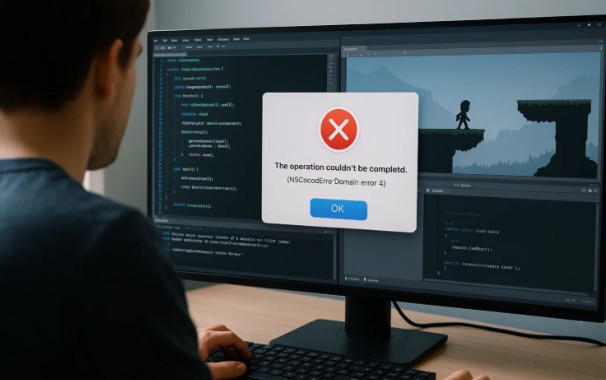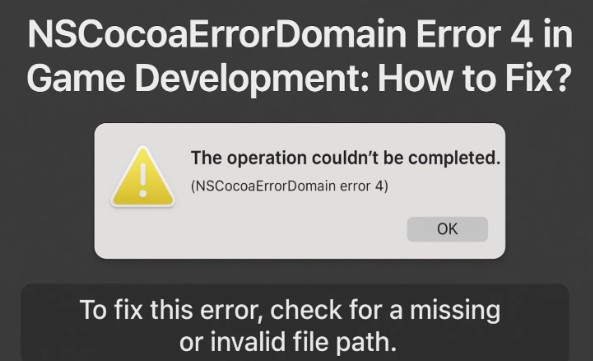What is NSCocoaErrorDomain Error 4?
When developing macOS or iOS applications using Apple’s Cocoa framework, developers may encounter various error messages. One of the most common and puzzling ones is NSCocoaErrorDomain Error 4, which typically appears as:
ErrorDomain=NSCocoaErrorDomain
ErrorMessage=Could not find the specified shortcut.
ErrorCode=4
In some cases, the error may appear as:
errordomain=nscocoaerrordomain&errormessage=could not find the specified shortcut.&errorcode=4
Though this error might seem cryptic at first, it is often caused by missing files, incorrect references, or issues related to automation scripts, user actions, or app configurations. This guide will walk you through understanding, diagnosing, and fixing NSCocoaErrorDomain Error 4, providing practical solutions for both technical and non-technical users.
Understanding the Error: What Does It Mean?

The NSCocoaErrorDomain is a set of error codes related to Apple’s Cocoa API, which is used in macOS and iOS development. Error Code 4 (also known as NSFileNoSuchFileError) typically indicates that the system cannot find the file or resource it is being asked to access.
- English: “Could not find the specified shortcut.”
- Spanish: “No se encontró el atajo especificado.”
- French: “Impossible de trouver le raccourci spécifié.”
This error can occur when the app is attempting to access a file, alias, or shortcut that either doesn’t exist, has been moved, or is not accessible due to permissions or system issues.
Common Causes of NSCocoaErrorDomain Error 4
Here are some of the most common scenarios that can trigger Error Code 4:
- Missing or Moved File/Resource
The application may reference a file path that either doesn’t exist anymore or has been changed (e.g., a missing .plist file or database).
- Deleted Automation Shortcuts (Apple Shortcuts App)
If a user or automation workflow has deleted shortcuts (like in macOS’s Shortcuts app), this error may appear when the app tries to trigger them.
- Incorrect UIKeyCommand Setup in Catalyst/iOS Apps
Misconfigured keyboard shortcuts or selectors may lead to missing references when the app is run on physical devices or Catalyst builds.
- System Updates or Migration
After upgrading macOS or iOS, file paths or automation setups may no longer be valid, leading to this error.
Sandbox Permissions
If the app is sandboxed and fails to access a file or directory due to permissions restrictions, the system may return this error.
Real-World Example: Fixing Error 4 in Board Game Duels

To provide a concrete example, let’s walk through how we encountered NSCocoaErrorDomain Error 4 during our game development for the digital adaptation of Board Game Duels. We were implementing keyboard shortcuts using UIKeyCommand and NSUserActivity for macOS and iOS. The shortcuts were working fine in the simulator but triggered this error on physical macOS devices and Catalyst builds.
How We Fixed It:
Upon investigation, we discovered the problem was caused by the fact that the shortcuts were being registered too early—before the view controllers were properly initialized and added to the window hierarchy. We needed to delay the shortcut registration until after the view appeared.
Here’s the fix we implemented:
swift
CopyEdit
override func viewDidAppear(_ animated: Bool) {
super.viewDidAppear(animated)
let resetCommand = UIKeyCommand(input: "R", modifierFlags: [.command], action: #selector(handleReset), discoverabilityTitle: "Reset Board")
addKeyCommand(resetCommand)
}
We also ensured that our NSUserActivity identifiers were unique and didn’t overlap with reserved system commands:
swift
CopyEdit
activity.activityType = "com.boardgameduels.useractivity.reset"
How to Troubleshoot NSCocoaErrorDomain Error 4
Now that we’ve identified the common causes and fixes, let’s look at some troubleshooting steps to resolve Error Code 4 in your own application.
1. Verify the File or Shortcut Exists
Start by checking if the file, shortcut, or resource the app is trying to access is still present. If it’s missing or has been moved, restore it from a backup or recreate it.
2. Check File Permissions
Ensure that the app has the necessary permissions to access the required file or folder. If your app is sandboxed, verify that the correct read/write permissions are granted.
3. Use Breakpoints and Log Files
In Xcode, use breakpoints to track where the error occurs. This will help you pinpoint which file or resource is missing. Also, examine the error logs for more details:
swift
CopyEdit
print(error.localizedDescription)
4. Validate Shortcuts and Automation
If your app relies on system shortcuts or automation scripts, confirm they haven’t been deleted or misconfigured. Use the Shortcuts app (for macOS) to double-check the validity of automation workflows.
5. Update the Application
If you’re using outdated code, system updates, or libraries, consider updating the app. For example, check if your app’s automation setup is compatible with the latest macOS or iOS versions.
Proactive Strategies to Prevent Error 4
Here are some strategies to help prevent this error from cropping up in the future:
- Delay Shortcut Registration
Ensure that shortcuts are registered only after the app’s view hierarchy is fully initialized. - Use Dynamic File Paths
Avoid hardcoding file paths. Use FileManager or Bundle.main.url(forResource:) to dynamically access files and resources. - Check for Missing Resources
Always verify the existence of files before trying to access them:
swift
CopyEdit
if FileManager.default.fileExists(atPath: filePath) {
// Proceed with file operations
} else {
// Handle missing file case
}
- Validate Permissions and Security Settings
If you are building a sandboxed app, ensure that the app has appropriate access rights to critical system resources.
Test on Multiple Devices
Test your app on both simulators and real devices (macOS, iOS, and Catalyst) to ensure cross-platform compatibility and catch issues before deployment.
SEO: Multilingual Context and Localization

As developers often work on global applications, it’s important to address NSCocoaErrorDomain Error 4 in multiple languages. Depending on the system locale, the error message will change:
- English: “Could not find the specified shortcut.”
- Spanish: “No se encontró el atajo especificado.”
- French: “Impossible de trouver le raccourci spécifié.”
To improve your app’s localization and SEO targeting, ensure that your documentation, error messages, and troubleshooting guides are available in multiple languages. Incorporate these localized phrases in your content, and always verify that localized error messages are handled appropriately in your code.
Wrapping Up: Resolving NSCocoaErrorDomain Error 4 Efficiently
NSCocoaErrorDomain Error 4 may seem like an intimidating message, but understanding its causes and implementing the right fixes can make troubleshooting manageable. Whether the error occurs due to a missing file, incorrect shortcut setup, or outdated paths, you can resolve it by following the strategies outlined in this guide.
For game developers, iOS, and macOS developers, being proactive—delaying shortcut registration, using dynamic file paths, and ensuring proper permissions—can prevent this issue from affecting your workflow. Don’t forget to test your app across devices and languages to catch potential issues early.
By recognizing the symptoms of this error and handling it appropriately, you’ll be able to create a more stable, reliable user experience.









